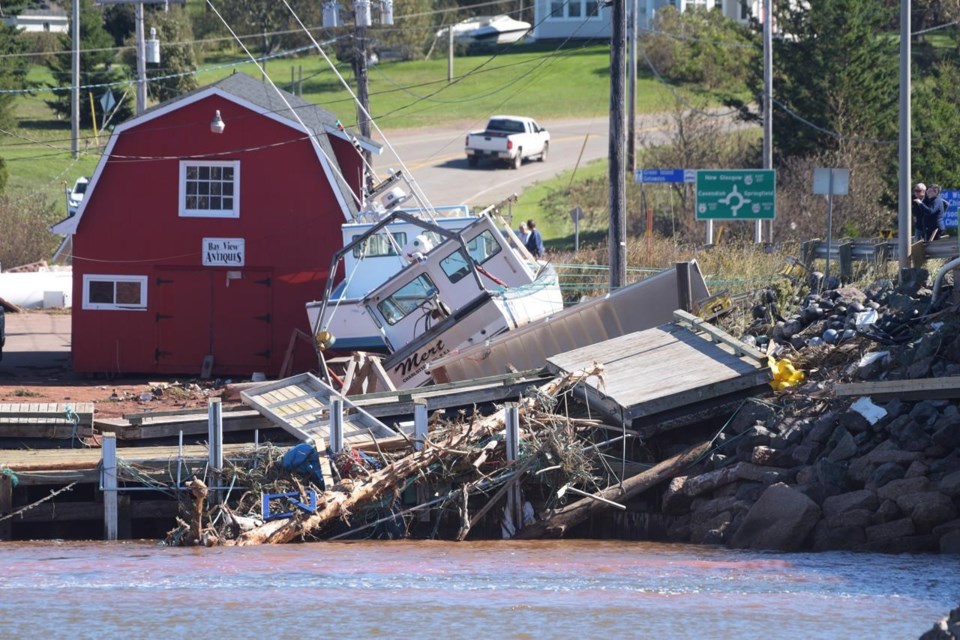ST. PETER'S BAY, P.E.I. — A national climate adaptation strategy released Thursday includes $1.6 billion in new spending to help communities faced with risks ranging from deadly heat waves and wildfires to floods and storms.
Bill Blair, the federal minister of emergency preparedness, announced the plan in Prince Edward Island, where post-tropical storm Fiona caused widespread damage to the power system, farms and the fishing industry when it swept through the region on Sept. 24.
During a tour of Red Head Harbour just before the news conference, Blair heard from a harbour master about how the resulting storm surge demolished the wharf, and fishers described their uncertainty about when they could return to work.
"What we're seeing in the last few years … is an increase in frequency and severity of climate-related events, and it demands action from us, not just actions from one order of government but from all of us, from every Canadian," Blair told the news conference.Â
The federal funding mostly tops up existing programs and won't cover the costs of major projects, such as the proposal to raise dikes that safeguard the land link between Nova Scotia and New Brunswick.
However, the plan adds $489 million to the federal disaster adaptation fund over 10 years, helping with smaller projects that address issues such as the risk to coastlines from rising seas and collapsing infrastructure due to permafrost thaw.
There is also $284 million over five years to strengthen wildfire management through measures such as the creation of larger fire breaks between forests and communities.
In addition, Ottawa will spend $164 million over five years on flood mapping and work with provinces and territories to expand a system that identifies areas at high risk of flooding. There is also $60 million over five years to update standards for new infrastructure and $95 million over five years to provide climate tool kits for citizens and local governments.
The plan includes $30 million over five years to expand Health Canada programs helping people protect themselves from extreme heat, and $13 million over five years to expand other health programs tied to the effects of climate change.
In climate change policy, mitigation refers to actions to reduce greenhouse gas emissions, which trap heat in the atmosphere and lead to global warming. Adaptation refers to actions adjusting to the reality of a warming planet.
Scientific assessments say that since 1948, annual average temperatures in Canada have increased by 1.7 C and 2.3 C in the North. Oceanographers have indicated that warmer waters added to the intensity of Fiona when it struck the Atlantic region, creating an estimated $660 million in insured damage.
The Insurance Bureau of Canada and the Federation of Canadian Municipalities have estimated that the three levels of government will need to spend about $5.3 billion annually to cope with climate adaptation.Â
However, experts say that figure could be lower if Canadians adapt to the climate we're facing now, instead of continuing to live in a country built for the climate of the past. The adaptation plan released by Blair sets targets to start this shift, though achieving these milestones would depend on co-operation from the provinces, territories and Indigenous communities.
For example, the strategy says that within three years, the goal is to have 80 per cent of health authorities across the country put in place measures to protect citizens from extreme heat, and by 2040 have systems in place to eliminate those types of deaths. Blair noted that British Columbia saw about 619 deaths during the heat wave in the summer of 2021.
The plan also calls for a clear set of codes and standards for infrastructure projects — from highways to water drainage systems — to be in place by 2030. The adaptation plan also suggests that preserving natural systems can help Canada reduce the effects of global warming, and it sets a target of conserving one-quarter of the country's lands and waters by 2025.
Louise Comeau, director of climate solutions at the Conservation Council of New Brunswick, said she's pleased the plan sets ambitious goals — including that six in 10 Canadians become "aware of the disaster risks facing their household" two years from now.
However, she said more details need to be provided on how these goals will be achieved, and she said provinces and territories should be required to agree to meet pre-set objectives before they receive the federal money.
"The $1.6 billion won't go very far … so they better be efficient with the money," she said.
This report by The Canadian Press was first published Nov. 24, 2022.
— By Michael Tutton in Halifax and Mia Rabson in Ottawa
The Canadian Press
Note to readers: This is a corrected story. A previous version said post-tropical storm Fiona caused an estimated $660 billion in insured damages.




